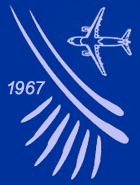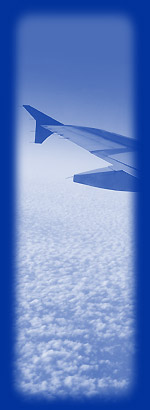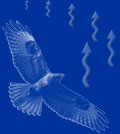|
The first scientific research in the sphere of birdstrike prevention was held by the members of State Scientific and Research Institute of Civil Aviation in 1967. The civil aviation managers had realized the specificity and complexity of the strike prevention problem, necessity of a long-term research in this area and the possibility of successful bird scaring activities. This brought to the appearance of a new separate subject in the main research institution, and the subject was aviational ornithology, with a number of collaborators working with it. As for the sphere of civil aviation, there appeared a new type of safety provision, an ornithological one.
The bird strike prevention research started more intensively after the USSR State Scientific and Technique Comitee Regulations №7 dated 10.01.1973 “On Expansion of the Bird Migration Research and Creation of the USSR Ornithological Service” The Regulations stated the importance of those ornithological works and highlighted the necessity of the research expansion concerning the applied ornithology sphere., including the aircraft protection form birds. According to the Regulations SCRI CA created the Birdstrike Prevention Methods Research Group. The next significant period for the sphere was in the mid-80’s and was connected with the Statement of the Comission of the USSR Ministers Council Presidium on the environmental provision and rational use of natural resources №5 dated 15.04.1986. This Statement refered not only to civil but military aviation as well.
In due course the pioneers of the subject (mostly technical specialists) were joined by the biologists and that was particularly important for the process of finding the salvations in the framework of birdstrikes. Since then from 2 to 4 aviational ornithologists were members of one of the of the departments (at first 113th , later 133th, 514 and others) or research centers (Environmental Safety Centre) SSRI CA forming a separate group. However in 2002 the last specialist in the sphere was dismissed and after 35 years of the research on the subject in SSRI CA was stopped. Since 2003 work on the same subject was started again by the State Centre of Flight Safety Civil Aviation (SCFS CA). At different periods of time the branch ornithology group imcluded I. Lipinsky, E. Utkin, Chernov, A. Rogachev, B. Jefanov, D. Palkin, V. Khodchenko, V. Lobanov, A. Galushina, G. Pilipchuk, V. Chichkin, Lazarev, R. Avramenko, S. Ryzhov.
The greatest role in the establishing and formation of the Group was played by Ph.D in biology V.E. Jacoby.
During the first stage of functioning (up to the 80s) the basic directions of the work were stated:
- Systematical analysis of the branch data and local information on the registered bird strikes, creation of a corresponding database and defining the character of danger caused by birds.
- Development and improvement of methods and means of bird detection and airport protection, scientific and developmental works and performance of coordinating function in the sphere
- Development of the branch documentation regulating the civil aviation activities aimed at birdstrikes prevention
- Consultations, methodical and practical help aimed at the decrease of danger at the airports, performace of the bracg expert function on the questions of ornithological provision, preparation of recommendations and instructions.
Analytical work with the bird strike data however was the first step in the work of the Group and still remains one of its leading directions. A few generations of specialists created a database containing information about all registered Russian and Soviet birds strikes since 1971 and continue filling it up. The analyses can be made showing general results or specifically for a region or a separate airport area.
Based on the analysis of 1981 AOG singled out 11 Soviet airports most favorable for the birds strike to appear. They were Vnukovo (Moscow), Borisopol (Kiev), airports in Kazan and Tashkent, Adler (Sochi), Tolmachevo (Novosibirsk), Pulkovo (Leningrad-St.Petersbourgh), Tallin airport, Koltsovo (Sverdlovsk –Ekaterinbourgh), Krasodar airport, Sheremetievo (Moscow). Under the USSR Civil Aviation minister decree in those airports for the first time a new position was introduced, which was the aviational ornithology engeneer.
A lot of attention of the group’s specialists has always been paid to the development and testing of various bird scaring means. Since the beginning of the 80s the development of a bioacoustic means was of a special interest to us. Under the Order of the USSR Ministry of Civil Aviation, with Civil Aviation Engineer University of Riga as a counterpart and with help of Tallin, Pulkovo, Sheremetievo and Vnukovo airports we developed several variants of mobile and individual bioacoustic devices, electrostimulator used for birds calls recording and a range of other technical devices for processing of the bird scaring signals.
The AOG specialists introduced the bioacoustic method into the branch by the serial release of mobile biouacoustic devises Berkut (literary “Golden eagle”). The Berkut was being produced by experimental factory of civil aviation № 20 (Kiev) in 1988-1989 and was used in more than 35 airports of the USSR. The AOG consulted airports and provided them with individual sets of signals recorded on the compact cassets to be used with the Berkut.
Experience achieved by the AOG during years of applying the bioacoustic method helped to develop Russian bioacoustic device of new generation, Universal-Acoustic. Universal-Acoustic was created in 2008-2009 in collaboration with specialists from the Severtsov University of Evolution and Ecology and The Two Wing LLC.
In the end of 80s with help of the Civil Aviation Engineer University of Riga we developed and successfully tested in Pulkovo (St.Petersbourgh) additional device for the survey radar allowing long-term gathering of information on birds migrations, named APE – Automatic Photoregistering Equipment. In the basis of the device was a photo camera registering flares left by birds on the survey radar screens in equal set time intervals.
In 1987 again in collaboration with the Civil Aviation Engineer University of Riga we developed and tested a remote control model of a bird of prey aimed at scaring birds away ad produced two operating items.
During a few years period collaborating with the University of Zoology and Parasitology of SSR of Lithoniawe carried out a research to define and estimate the most efficient measures and methods of birdstrike prevention.
In 1997-2005 period we operated we assisted delivery of the bioacoustic equipment of Bird Guard series into the Russian market.
In 1994-95 with the help of the University of Applied Chemistry we developed pyrothechnical birdscaring device for the aerodromes Khalzan. For a short period of time Khalzan was being serially released and applied at Pulkovo (St.Petersbourgh), Sokol (Magadan), Nefteyugansk and Nizhnevartovsk airports, Actafievo (Moscow area) ad some others.
In 2000 on the territory of a model object situated in the Moscow area and on the basis of quantitative research we estimated the efficiency of application of birds of prey against birds of other species.
In 1998 the AOG initiated negotiations on the topic of the airports being responsible for birds strikes with the planes of Aeroflot, national airlines. After a range of consultations , one member of the Airlines Flight Safety Inspection was to pay primary attention to the investigation of incidents with birds. And in 2003 Aeroflot for the first time applies for the arbitration with the question of the responsibility of the land services for the bird strikes. The AOG consulted the insurance company Afes on the same topic as well.
In the long run the AOG worked with many Soviet and Russian airports and developed complex recommendation on the improvement of the safety provision.
During years of work the AOG specialists worked out Methods of short-term birds migration prognosis, Methods of radar birds detection, Methods of analysis ad estimation of ornithological environment, Methodical basis of the ecological ornithological investigation, Methodical instructions on visual and radar supervision of birds movements at the civil aviation aerodromes, List of USSR civil aviation activities aimed at improvement of ornithological provision of flight safety for 1981-85, List of activities aimed at birdstrike prevention, List of Birdscaring equipments for the airports, student course The Basis of the Aviational Ornithology for cadets of flight schools and students of avia-techical universities.
We released propaganda films “Birds give way” (Part 1 – 1983, Part 2 – 1984) and “ The Use of the Aerodrome Radars for Birds Detection” and in addition a screen play for educational film on the ornthiligical provision was written. We also prepared and published 50 copies of a photo album with tracks of echo-signals produced by birds displayed on the radar screen, a circulation of a series of posters “Estimation of the Ornithological Conditions” consisting of 5 items and first and the only Russian manual on the ornithological provision.
Memebers of the AOG took part in all meetings and sessions concerning question of the ornithological provision. In October 2000 we launched first website in the Russian language dedicated to birds scaring problem.
In October 1982 the AOG for the first time in Russia we held The Avaitaional Ornithology Engineers Gathering in common with First All-Union Session on the ornithological Provision of the Safety of Flights of the Civil Aviation inviting more than 20 companies of the aviation sector.
Members of the AOG also took active part in preparation and operation of the 16 EBSC-IBSC in Moscow alongside with the 18th International Ornithological Cnogress of 1988 and The First Scientifically-Technological Conference “Problems of the Aviational Ornithology” (Moscow, 2009).
In 2012 after a long break the AOG together with the Two Wings Company has resumed Russia's participation in the work of the International Bird Strike Committee.
|






